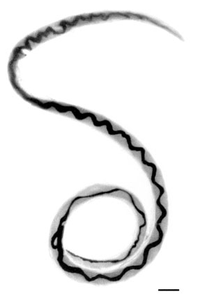
Photo from wikipedia
The incidental discovery of pre-clinical interstitial lung disease (ILD) has led to the designation of interstitial lung abnormalities (ILA), a radiological entity defined as the incidental finding of computed tomography… Click to show full abstract
The incidental discovery of pre-clinical interstitial lung disease (ILD) has led to the designation of interstitial lung abnormalities (ILA), a radiological entity defined as the incidental finding of computed tomography (CT) abnormalities affecting more than 5% of any lung zone. Two recent documents have redefined the borders of this entity and made the recommendation to monitor patients with ILA at risk of progression. In this narrative review, we will focus on some of the limits of the current approach, underlying the potential for progression to full-blown ILD of some patients with ILA and the numerous links between subpleural fibrotic ILA and idiopathic pulmonary fibrosis (IPF). Considering the large prevalence of ILA in the general population (7%), restricting monitoring only to cases considered at risk of progression appears a reasonable approach. However, this suggestion should not prevent pulmonary physicians from pursuing an early diagnosis of ILD and timely treatment where appropriate. In cases of suspected ILD, whether found incidentally or not, the pulmonary physician is still required to make a correct ILD diagnosis according to current guidelines, and eventually treat the patient accordingly. In patients with interstitial lung abnormalities (ILA), monitoring of those at risk of progression is currently recommended, and pulmonary physicians should pursue an early diagnosis when ILA become clinically significant to facilitate timely treatment https://bit.ly/3HKOQc8
Journal Title: European Respiratory Review
Year Published: 2022
Link to full text (if available)
Share on Social Media: Sign Up to like & get
recommendations!